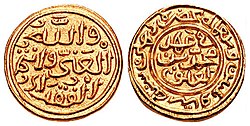Tughlaq dynasty
The Tughlaq dynasty (also known as Tughluq or Tughluk dynasty; Persian: تغلق شاهیان) was the third dynasty to rule over the Delhi sultanate in medieval India.[1] Its reign started in 1320 in Delhi when Ghazi Malik assumed the throne under the title of Ghiyath al-Din Tughluq. The dynasty ended in 1413.[2][3][4]
The dynasty expanded its territorial reach through a military campaign led by Muhammad Bin Tughluq, and reached its zenith between 1330 and 1335. It ruled most of the Indian subcontinent for this brief period.[5][6]
Tughlaq Dynasty Media
Ghiyasuddin Tughlaq ordered the construction of Tughlakabad, a city near Delhi with a fort, to protect the Delhi Sultanate from Mongol attacks. Above is the Tughlaq fort, now in ruins.
Ghiyath al-Din Tughluq leading his troops in the capture of the city of Tirhut, from the Basātin al-uns by Ikhtisān-i Dabir, a member of the Tughluq court. Ca.1410 Jalayirid copy of 1326 Tughlaq dynasty lost original. Istanbul, Topkapi Palace Museum Library, Ms. R.1032.
Gold coinage of Muhammad bin Tughluq (r. 1325–1351)
City of Delhi ("ciutat de delly"), capital of the Tughlaqs, in the Catalan Atlas (1375).
Mughal painting depicting the court of Ghiyath al-Din Tughlaq.
References
- ↑ Lombok, E.J. Brill's First Encyclopedia of Islam, Vol 5, ISBN 90-04-09796-1, pp 30, 129-130
- ↑ Cite error: Invalid
<ref>tag; no text was provided for refs namedewoxford. - ↑ Sen, Sailendra (2013). A Textbook of Medieval Indian History. Primus Books. pp. 90–102. ISBN 978-9-38060-734-4.
- ↑ Eaton, Richard Maxwell (2015-03-08). The Sufis of Bijapur, 1300-1700: Social Roles of Sufis in Medieval India. Princeton University Press. pp. 41–42. ISBN 978-1-4008-6815-5.
- ↑ Cite error: Invalid
<ref>tag; no text was provided for refs namedpjackson2003. - ↑ W. Haig (1958), The Cambridge History of India: Turks and Afghans, Volume 3, Cambridge University Press, pp 153-163








